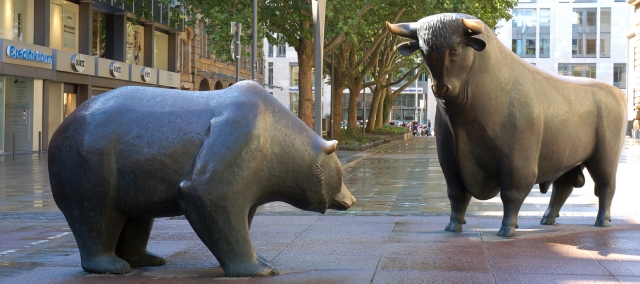If you've been watching the markets this week you will have noticed that stock prices in China have been on the slide, that the Dow Jones Industrial Average seems to have caught a cold and that the ASX200 has been staring into the dark tea time of the soul and wondering about its existence. When stock prices fall, we call it a "bear market" and conversely when they rise, we call it a "bull market". The stories for these names are shrouded in mystery but as far as I can tell, the reason for this is either of the following.
- Outside the Frankfurter Wertpapierbörse - the Frankfurt Stock Exchange
It might have something to do with the way these animals attack. A bull is likely the lower its head and throw the target into the air - it lifts its enemy. A bear will rise up and using its claws and massive paws - it beats down its enemy. It could also have to do with the way that bulls charge forward and bears go into hibernation.
What I find somewhat strange is that in New York City, there is a statue of a charging bull which is supposes to represent the unpredictability of the stock market, there is no corresponding statue of a bear.
Whilst it's true that we just don't know what the bull and bear are actually supposed to mean or where they originally came from, we do know the story behind the animal mascots for the political parties in the United States.
- Thomas Nast's cartoons from Harper's Magazine, 1870 & 1874
The image of the Democratic Party as a donkey, goes back to the days when Andrew Jackson was running for president. During the 1828 campaign, his opponents would call him a "jackass" and instead of running away from this, he embraced the metaphor and redefined it to mean that he was steadfast, willful and determined instead of being obstinate.
The image was forgotten and then revived in the 1870's by Harper's Magazine when resident cartoonist Thomas Nast made fun of the "Copperheads", a vocal faction of Democrats, so named after the venomous snakes.
Likewise, Nast is also responsible for creating the Republican elephant, which was portrayed as belligerent and clumsy. Among other things, Thomas Nast probably also developed the ideas of Santa Claus, Uncle Sam, Columbia and New York's Tammany Hall Tiger.
This leads me to think about what we should do for Australia.
We have two political major political parties who have been locked in the perpetual shouting match across the floor of parliament since 1945. I think that it would be fitting if we could take inspiration from the coat of arms and use the Kangaroo and Emu.
The Labor Party would be the Kangaroo. It stands on the let of the coat of arms and has sometimes been provided with boxing gloves in various contexts.
The Liberal Party would be the Emu. It stands on the right of the coat of arms; which itself is an apt metaphor for the party.
Neither the Kangaroo or the Emu can walk backwards, both have as much road sense as a flying pavlova and both rush about at incredible speeds without the slightest regard for anything else in their environment.
Or maybe not. We already have a Walkley Winning cartoonist in Australia who has given us Ian the Climate Denialist Potato, the Racist Carrot and Brenda the Civil Disobedience Penguin.



No comments:
Post a Comment